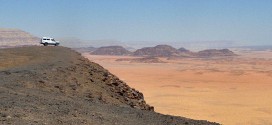
Set beneath the mountain where Moses is said to have received the Ten Commandments, Saint Catherine Monastery has been one of the world’s great centers of religious pilgrimage for over fifteen centuries. Within its imposing walls sits a citadel like no other, its important structure rich of religion and history. Among its treasures a library of ancient manuscripts and icons, its importance only second to the Vatican’s itself, and a 6th Century church reputed to lie directly on the site of the Burning Bush. Quite simply, the monastery is a defining feature of the Holy Land.
The Moses Mountain
By any other standards, Mt. Sinai would be just another barren peak lost among the rough landscape of southern Sinai. It is neither the highest mountain in the region, nor the most dramatic shaped; there is no soaring, heaven-reaching apex, and it is rare to see anything resembling a divine shroud of clouds hugging its peak. If not for a single, overwhelming belief that has endured over fifteen centuries, Mt. Sinai would probably be a topographical footnote – but this is the mountain where God spoke to Moses.
It seems strange, almost, to speak of Mt. Sinai in clinical terms. There is so much mystery surrounding the mountain, so much spiritual projection and adulation that one can easily forget that it is, after all, a mountain, and climbing it requires an individual to be in moderate shape. It takes about 3 hours to climb the 2.285 meters peak following the path of Moses, a stairway of nearly 4,000 steps. There is a longer, less strenuous route up the opposite side, though it is less scenic. In both cases, one should bring good hiking shoes and plenty of water, the latter of which Moses himself probably brought when he climbed up.
That, at least, is the overwhelming belief, and the belief itself has drawn pilgrims for over a thousand years. Although no archaeological evidence of Moses’ presence on the mountain exists, there are abundant relics of faith throughout the eons.
Ancient chapels and structures honoring saints and the Virgin Mary appear all along the main route, called Sikket Saydna Musa (The Path of Moses), including a stone-hewn arch where, long ago, a monk once sat and heard confession from the pilgrims. Nearing the summit, one encounters the natural amphitheater where the 70 wise men waited God to speak with Moses, then finally a small chapel and a mosque at the top.
St. Catherine Monastery
Located at the foot of Mount Moses, St. Catherine’s Monastery was constructed by order of the Emperor Justitian between 527 and 565. It is built around what is believed to have been the biblical Burning Bush with a chapel built atop of it which is a work of art of itself, including Arab mosaics, Greek and Russian icons, western oil paintings, wax paintings, fine sacerdotal ornaments, works of marble, enamels, chalices, reliquaries, including one donated by Czar Alexander II in the 19th Century, and another by the Empress Catherine of Russia in the 17th Century.
But of perhaps even greater significance is the second largest collection of manuscripts in the world (the Vatican has the largest). The collection consists of 3,500 volumes in Greek, Coptic, Arabic, Armenian, Hebrew, Slavic, Syrian, Georgian and other languages. About 1850, the fourth century Codex Sianiticus, which is now in the British Museum in London, was discovered here. A small chapel (the Chapel of St. Triphone) which is known as the Skull House as well as a small mosque dating to the 10th or 11th century, settle within the walls of the monastery.
St. Catherine has a rich history. It is the oldest working Christian monastery, though St Antony’s predates it, and the smallest diocese in the world. The monastery was originally ordered to be built by Empress Helen, the mother of Constantine the Great, but was actually built by Emperor Justitian to house the bones of St. Catherine of Alexandria. Her lyrics are carved in marble in the Basilica. The Monastery of St. Catherine is also a formidable fortification with granite walls standing 12 to 61 meters high, surrounded by gardens and cypresses. Prior to the twentieth century, the only entrance to St. Catherine’s was a small door 9 meters above the ground, where people and provisions were lifted up with a system of pulleys. The monastery withstood numerous attacks over its 1,400 years existence thus protecting a rich collection of art. Its original preserved state is unmatched. Though established and most of its history under the rules of the Russian Orthodox Church, it is now under the auspices of the Greek Orthodox Church.
 Sakura Travel World Group
Sakura Travel World Group








